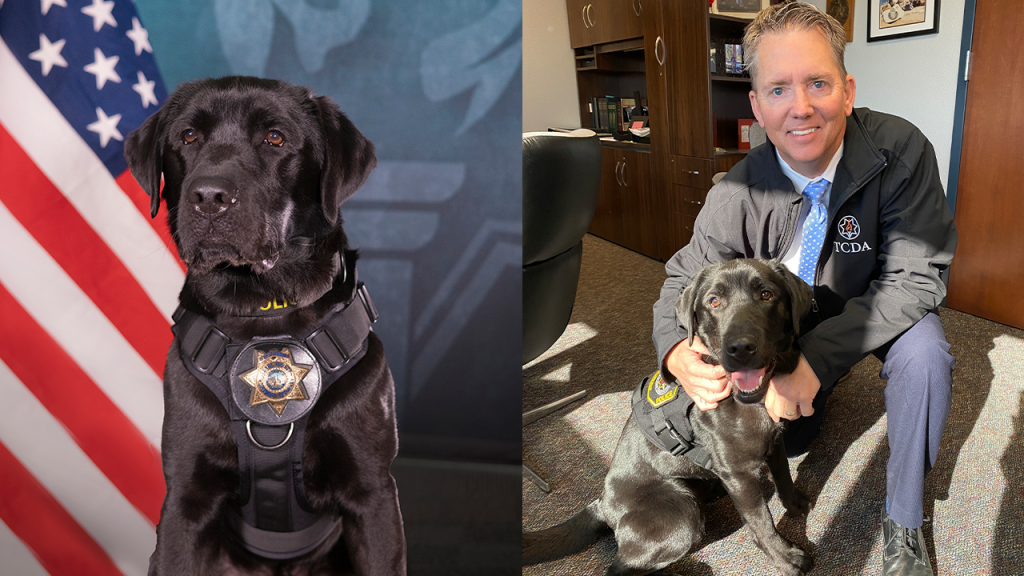Tulare County, California, has taken a significant step in combating the rising tide of cybercrimes with the introduction of an innovative electronic detection K-9 named Tor. As the first of its kind in the county, the black Labrador retriever is specially trained to identify electronic devices linked to various criminal activities, such as child pornography and fraud. District Attorney Tim Ward expressed enthusiasm over this initiative, asserting that Tor will enhance the office’s efforts to address crimes of a technological nature while offering hope to victims.
| Article Subheadings |
|---|
| 1) Introduction of Tor: A Unique Canine Asset |
| 2) The Selection Process for Electronic Detection Dogs |
| 3) Tor’s Training and Unique Abilities |
| 4) How Tor Affects Crime Fighting Strategies |
| 5) The Broader Implications of Tor’s Involvement |
Introduction of Tor: A Unique Canine Asset
The Tulare County District Attorney’s Office has recently introduced Tor, an electronic detection K-9, as part of its strategy to tackle an increase in cybercrimes. District Attorney Tim Ward emphasized the importance of this addition, highlighting that it marks a commitment to innovate in the fight against crimes involving electronics. “I’ll be honest, when my chief investigator came to me with this concept as an idea, I honestly didn’t know if she was joking or not,” explained Ward. However, the need has become apparent as the county sees a rise in offenses facilitated by technology, including child exploitation and financial fraud.
The Selection Process for Electronic Detection Dogs
Tor was selected as part of a nationwide initiative in which 12 district attorneys’ offices received an electronic detection dog through a program developed by the National Forensic Institute of the U.S. Secret Service. This competitive selection process underscored the office’s position as a leader in addressing not only traditional crimes but also modern threats. “We’re pretty honored to be included with that,” said Ward. His office has focused on crimes against children and white-collar crime, making Tor’s specialized capabilities even more crucial for their ongoing efforts.
Tor’s Training and Unique Abilities
Tor, a two-year-old black Labrador retriever, undergoes specialized training to detect triphenylphosphine oxide (TPPO), a chemical commonly found in electronic storage devices such as USB drives, hard drives, and smartphones. This training draws parallels with traditional K-9 work, likened to narcotics or explosives detection. “The concept is not too far-fetched from a canine narcotic dog trained to smell narcotics,” stated Ward. The purpose behind Tor’s training is to assist law enforcement in unearthing hidden electronic devices that may contain important evidence in various criminal investigations. Tor’s handler, Anthony Benitez, noted that electronic storage detection K-9s have become increasingly utilized since 2015, and Tor represents the next generation in this expanding field.
How Tor Affects Crime Fighting Strategies
The introduction of Tor allows for a more refined approach to law enforcement procedures, especially when it comes to searching homes or locations where suspects may hide electronic devices. Benitez explained that these devices, often small and cleverly concealed, may evade traditional searches. With Tor on the force, law enforcement agencies can enhance their search capabilities, discovering electronic evidence that could have significant implications for a case. “Tor would indicate the chemical TPPO found on the device and not on the content,” added Benitez, emphasizing the forensic analysis process that follows these discoveries.
The Broader Implications of Tor’s Involvement
Ward underscored the evolving nature of crime, particularly regarding the intersection between child exploitation and white-collar crime. He indicated an alarming trend of increased instances involving fraud, embezzlement, and even severe cases of financial crimes linked to child exploitation. “There’s been a significant correlation between those offenses as technology has advanced,” he noted. With Tor acting as a tool for transparency and accountability, Ward believes it sends a critical message to both the community and potential offenders: that law enforcement is equipped to tackle these growing challenges seriously. By addressing the victims of crime, he hopes to bring a sense of hope and security back to those affected.
| No. | Key Points |
|---|---|
| 1 | Tor is the first electronic detection K-9 introduced by the Tulare County District Attorney’s Office. |
| 2 | The dog’s ability to detect electronic devices enhances law enforcement’s search capabilities. |
| 3 | Tor’s training focuses on identifying a chemical used in various electronic storage devices. |
| 4 | District Attorney Tim Ward emphasizes the increasing complexity of cybercrimes in the county. |
| 5 | The initiative aims to provide hope to victims of electronic crimes while deterring potential offenders. |
Summary
The introduction of Tor as an electronic detection K-9 into Tulare County’s law enforcement arsenal exemplifies the adaptive strategies taken to combat the modern landscape of crime, particularly in cybercrime. With Tor’s specialized training and capabilities, law enforcement aims to enhance victim protection and evidence recovery in cases that traditionally rely heavily on digital evidence. District Attorney Tim Ward remains optimistic that Tor will yield significant strides in addressing the complicated nexus of technology and criminal behavior, making a substantial impact in creating a safer community.
Frequently Asked Questions
Question: What is an electronic detection K-9?
An electronic detection K-9 is a specially trained dog that can detect chemicals found in electronic storage devices, thus assisting law enforcement in locating potentially hidden evidence related to crimes.
Question: How does Tor assist in criminal investigations?
Tor identifies the presence of triphenylphosphine oxide (TPPO), a chemical in devices like USB drives and cellphones, helping investigators uncover hidden electronic evidence that may be crucial in criminal cases.
Question: Why are law enforcement agencies adopting electronic detection dogs?
With the rise in cybercrime and its complexities, law enforcement agencies are adopting electronic detection dogs like Tor to stay ahead of criminals who leverage technology in illegal activities, thereby enhancing their investigative capabilities.


